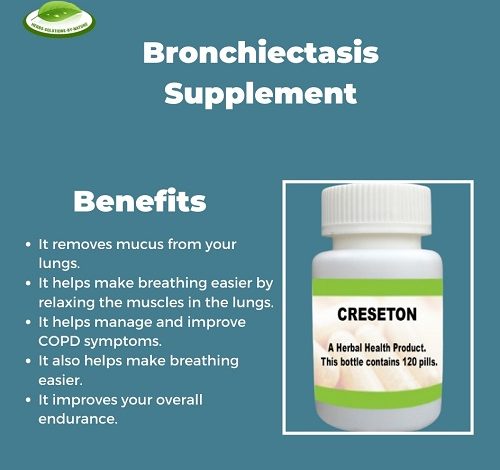How to Manage Bronchiectasis Chest Pain: Natural Treatment Options

Bronchiectasis chest pain is a common symptom experienced by those living with bronchiectasis, a chronic lung condition. It can be a source of discomfort and can significantly impact one’s quality of life. While there are various medical treatments available for bronchiectasis chest pain, many people are turning to natural treatment options for relief. The causes of bronchiectasis chest pain and explore some natural treatment options that can help manage this symptom. By incorporating these natural treatments into your routine, you may find relief from bronchiectasis chest pain and improve your overall well-being.
Understanding Bronchiectasis and Chest Pain
Bronchiectasis is a chronic lung condition characterized by the permanent widening and scarring of the airways. This can lead to a variety of symptoms, including chest pain. Chest pain in bronchiectasis is often caused by inflammation and infection in the lungs, as well as the accumulation of mucus in the airways.
Chest pain can be a distressing and uncomfortable symptom that can greatly impact the quality of life for individuals with bronchiectasis. It can range from mild discomfort to severe pain, and may be accompanied by breathlessness and a feeling of tightness in the chest.
Understanding the underlying causes of bronchiectasis chest pain is crucial in effectively managing this symptom. It is important to work closely with your healthcare provider to determine the best treatment plan for you. In addition to medical interventions, many individuals with bronchiectasis are turning to natural treatment options for relief.
Natural treatment options that can help manage bronchiectasis chest pain. These options include breathing exercises, respiratory techniques, a healthy diet, exercise, adequate sleep and rest, complementary therapies, and the power of maintaining a positive attitude. By incorporating these natural treatments into your routine, you may find relief from bronchiectasis chest pain and improve your overall well-being.
Stay tuned as we delve deeper into each of these topics and provide practical tips and strategies for managing chest pain in bronchiectasis.
The Importance of Breathing Exercises in Managing Chest Pain
Breathing exercises play a crucial role in managing chest pain associated with bronchiectasis. When you have bronchiectasis, your airways are often narrowed or obstructed, making it difficult to breathe properly. This can lead to a feeling of breathlessness and chest pain. However, by incorporating regular breathing exercises into your routine, you can improve your lung function and reduce the severity of chest pain.
One of the most effective breathing exercises for bronchiectasis is diaphragmatic breathing. This technique focuses on deep, slow breaths that engage the diaphragm, the primary muscle responsible for breathing. By practicing diaphragmatic breathing, you can strengthen your diaphragm and increase your lung capacity, allowing for better oxygenation and reducing the strain on your respiratory system.
Another beneficial breathing technique is pursed-lip breathing. This involves inhaling deeply through your nose and exhaling slowly through pursed lips. Pursed-lip breathing helps to control your breathing rate, improve oxygen exchange, and alleviate the sensation of The Natural Way to Ease Breathlessness in Bronchiectasis Patients.
In addition to breathing exercises, there are bronchiectasis natural treatment options that can complement your efforts in managing chest pain. Consider incorporating All Natural Organic Supplements like Creseton into your daily routine. Creseton is a powerful antioxidant-rich supplement that can help reduce inflammation in the lungs and promote better respiratory health.
Remember, it’s important to consult with your healthcare provider before starting any new breathing exercises or natural treatments. They can provide personalized guidance and ensure that these techniques are safe and effective for your specific condition. With regular practice and the support of natural treatments, you can find relief from bronchiectasis chest pain and improve your overall well-being.
Breathing Techniques and Respiratory Exercises
Breathing techniques and respiratory exercises are essential components of managing bronchiectasis chest pain. By incorporating these practices into your daily routine, you can improve your lung function and alleviate discomfort.
One effective breathing technique is deep belly breathing. This involves taking slow, deep breaths, focusing on expanding your belly as you inhale and contracting it as you exhale. Deep belly breathing helps to fully oxygenate your lungs and relax the respiratory muscles, reducing chest pain.
Another beneficial exercise is pursed-lip breathing. This technique involves inhaling deeply through your nose and exhaling slowly through pursed lips, as if you are blowing out a candle. Pursed-lip breathing helps to control your breathing rate, improve oxygen exchange, and alleviate the sensation of breathlessness associated with bronchiectasis.
In addition to these breathing techniques, incorporating Bronchiectasis Natural Treatment options like All Natural Organic Supplements into your routine can provide further support. Consider using top best supplements such as Creseton, which is a powerful antioxidant-rich supplement that can help reduce inflammation in the lungs and promote better respiratory health.
Remember to consult with your healthcare provider before starting any new breathing exercises or using supplements. They can provide personalized guidance and ensure that these techniques are safe and effective for your specific condition. With regular practice and the support of natural treatments, you can find relief from bronchiectasis chest pain and improve your overall well-being.
How a Healthy Diet Can Aid Chest Pain Management
A healthy diet plays a crucial role in managing chest pain associated with bronchiectasis. By fueling your body with nutritious foods, you can support your respiratory health and reduce inflammation in the lungs, which can help alleviate chest pain. Incorporating the Top Best Supplements for bronchiectasis, such as Creseton, can further enhance the benefits of a healthy diet.
To aid chest pain management, it is important to consume foods that are rich in antioxidants and anti-inflammatory properties. These include fruits and vegetables like berries, leafy greens, and citrus fruits. Omega-3 fatty acids found in fatty fish like salmon and sardines can also help reduce inflammation. Additionally, incorporating foods high in vitamin C, such as bell peppers and kiwi, can support respiratory health.
Avoiding trigger foods and substances that may exacerbate chest pain is equally important. These may include processed foods, sugary snacks, and drinks, as well as tobacco smoke and alcohol.
By following a healthy diet and incorporating Natural Treatment for Bronchiectasis options, like Creseton, into your routine, you can effectively manage chest pain and improve your overall well-being. Remember to consult with your healthcare provider for personalized guidance and recommendations on dietary modifications specific to your condition. With a well-rounded approach, you can find relief from bronchiectasis chest pain and support your respiratory health.
The Role of Exercise in Chest Pain Reduction
Regular exercise plays a vital role in reducing chest pain associated with bronchiectasis. Engaging in physical activity helps strengthen the muscles involved in breathing and improves overall lung function, which can alleviate chest pain and The Natural Way to Ease Breathlessness in Bronchiectasis Patients.
When it comes to exercise, it’s essential to find activities that suit your fitness level and limitations. Low-impact exercises such as walking, swimming, and cycling are great options for individuals with bronchiectasis. These activities provide cardiovascular benefits without putting excessive strain on the respiratory system.
Incorporating breathing exercises into your exercise routine can further enhance its benefits. Practicing deep belly breathing or pursed-lip breathing while exercising can help regulate your breathing and reduce the likelihood of chest pain during physical activity.
It’s important to start slowly and gradually increase the intensity and duration of your exercise sessions. Listen to your body and take breaks as needed. Remember, even short periods of exercise can be beneficial.
Before starting any exercise program, it’s crucial to consult with your healthcare provider to ensure that you are engaging in safe and appropriate activities for your condition. They can provide guidance on specific exercises and help create an exercise plan tailored to your needs.
By incorporating regular exercise into your routine, you can reduce chest pain, improve your respiratory health, and enhance your overall well-being. Stay motivated and find enjoyable activities that keep you moving, and you’ll soon experience the positive impact of exercise on managing bronchiectasis chest pain.
Importance of Adequate Sleep and Rest in Pain Management
Getting enough sleep and rest is crucial when it comes to managing bronchiectasis chest pain. Sleep deprivation can worsen symptoms, including chest pain, and make it more challenging to cope with the condition. When you don’t get enough rest, your body becomes fatigued, making it harder to breathe properly and increasing the strain on your respiratory system. This can exacerbate chest pain and make it even more uncomfortable.
Adequate sleep allows your body to repair and recharge, giving your respiratory system the opportunity to recover. It helps reduce inflammation, improve immune function, and support overall well-being. Establishing a consistent sleep schedule, practicing good sleep hygiene, and creating a relaxing bedtime routine can all contribute to a better night’s sleep.
Additionally, incorporating periods of rest throughout the day can also help manage chest pain. Taking short breaks to relax and focus on deep breathing can provide relief and reduce stress levels. Prioritizing rest and relaxation can significantly improve your quality of life and help alleviate bronchiectasis chest pain.
Remember, everyone’s sleep needs are different, so it’s important to listen to your body and give yourself the rest you need. Consult with your healthcare provider for personalized advice on how to optimize your sleep and rest routine. With adequate sleep and rest, you can effectively manage chest pain and support your overall respiratory health.
Exploring Complementary Therapies
When it comes to managing bronchiectasis chest pain, exploring complementary therapies can be a valuable addition to your treatment plan. These therapies, which focus on holistic and natural approaches, can help alleviate symptoms and improve overall well-being.
One complementary therapy worth considering is acupuncture. This ancient practice involves the insertion of thin needles into specific points on the body. It has been shown to promote relaxation, reduce inflammation, and relieve pain. Acupuncture may be particularly beneficial for individuals with bronchiectasis chest pain, as it targets the underlying causes of discomfort.
Another complementary therapy to explore is herbal medicine. Certain herbs and botanical extracts have anti-inflammatory and expectorant properties, which can help reduce mucus production and alleviate chest pain. Herbal remedies like ginger, eucalyptus, and licorice root may be used in various forms, such as teas or tinctures, to support respiratory health.
Additionally, mindfulness practices such as meditation and yoga can help reduce stress and promote relaxation. By incorporating these practices into your daily routine, you can enhance your overall well-being and Creseton Bronchiectasis Herbal Remedies Change a Lifestyle Naturally.
It’s important to remember that complementary therapies should not replace medical treatment, but rather complement it. Consult with your healthcare provider before incorporating any new therapies to ensure they are safe and suitable for your specific condition. With a holistic approach that combines traditional medicine with complementary therapies, you can find relief from bronchiectasis chest pain and improve your quality of life.
The Role of a Positive Attitude in Managing Chest Pain
Having a positive attitude can play a significant role in managing chest pain associated with bronchiectasis. While it may not directly eliminate the physical symptoms, maintaining a positive mindset can help improve your overall well-being and quality of life.
Living with bronchiectasis can be challenging, and it’s normal to feel frustrated or discouraged at times. However, adopting a positive attitude can help you cope better with the pain and discomfort. It can give you the motivation to keep pushing forward and actively seek out solutions for managing your symptoms.
A positive attitude can also have a profound impact on your mental health. By focusing on the things you can control, such as implementing Herbal Treatment for Bronchiectasis, practicing self-care, and seeking support from loved ones and healthcare professionals, you can regain a sense of empowerment and hope.
Furthermore, maintaining a positive mindset can help reduce stress and anxiety, which can often exacerbate chest pain. Stress management techniques such as deep breathing, meditation, and engaging in activities you enjoy can all contribute to a more positive outlook.
While a positive attitude alone may not be a cure. It can be a powerful tool in your arsenal for managing bronchiectasis chest pain. By approaching your condition with positivity and resilience, you can navigate the challenges more effectively and improve your overall well-being. Remember, you are not alone in this journey, and there are resources and support available to help you along the way.




